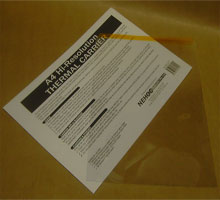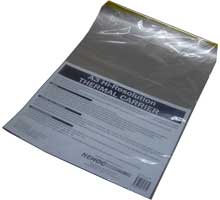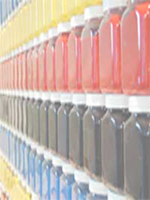
Hi-Resolution Budget Thermal Carriers
Product Code: R-TCA4 and R-TCA3
Carriers are used to hold the item when passing through the Thermal-Copier to stop designs wrapping around the glass roller and causing a jam.
Screen Printing
Artwork and RISO ScreenMaster are held together and run through the machine to create an imaged screen printing screen. Full instructions in the A4 Thermal-Copier Operation Manual, see Product Home below.
Tattoo Sprit Masters
Artwork and Tattoo Spirit Masters (with protective sheet removed) are held together and run through the machine to create a tattoo stencil.
Available Sizes
 |
A4 Hi-Resolution Budget Carrier Higher resolution but shorter life span compared to CS04 Teflon Carrier |
 |
A3 Hi-Resolution Budget Carrier Higher resolution but shorter life span compared to CS03 Teflon Carrier |
- Product Home
- Specifications
- Accessories
- Support
Key Features
Poly carbonate construction provides high quality images
High temperature Kapton tape header tape
Cut header corners to avoid jamming
Reversible - both sides can be used
Protective storage cover
Usage
Both sides may be used as the top - lift and place your artwork ‘face up’ inside the carrier.
ScreenMaster: Cut ScreenMaster to size and insert into the carrier over your artwork, with the film side (smooth) facing down against the artwork.
Thermal Tattoo Paper: Remove the protective paper from 3 layered sheet and insert artwork, face up, behind the carbon sheet.
Turn the thermal copier on and feed the carrier into the machine at the required setting (see manual for machine setting details).
When the carrier begins to emerge from rear, hold/pull and support the carrier, then remove it from machine.
Open the carrier to remove your design and return carrier to the protective envelope immediately.
Information Sheets 36 - Thermal Carrier Instruction Guide - view now . .
IS36 - Thermal Carrier Instructions
Cleaning
Carrier will naturally mark and scratch much faster than NEHOC’s Teflon covered carriers (CS03 & CS04).
To maximise life of the carrier:
Clean top and bottom of cover with a lint free cloth before each use
Return to protective cover immediately after use
Contents
Thermal Carrier
Protective Cover
Instructions
R-TCA4 A4 Thermal Carrier ![]() View large image . .
View large image . .
R-TCA3 A3 Thermal Carrier ![]() View large image . .
View large image . .
Specifications

 R-TCA4 A4 Hi-Resolution Budget Carrier
R-TCA4 A4 Hi-Resolution Budget Carrier
Item Weight [Kg]: 0.08
Width: 23cm
Length: 33cm
Cbm: 0.038 Kg
R-TCA3 A3 Hi-Resolution Budget Carrier
Item Weight [Kg]: 0.15
Width: 31cm
Length: 45cm
Cbm: 0.07 Kg
Price and Availability
All prices are online in NEHOCdirect - select the 'Just Looking' option in Step 2.
Ask a Question
Complete the Product Assistance Form for a quick reply to any question not answered in the FAQ's or training section - click here . . Select the product code listed at the top of this page.
FAQ's
Can the ScreenMaster mesh be re-used after a design has been imaged onto it?
How detailed can the artwork get?
Once a screen is created, how many prints will I get before the quality lessens?
Can I clean the screens and use them again as many times as I want?
Each time I use a mesh stencil . . . . do I have to clean it with a solution?
How do you recommend we store our screens?
![]()
'Can the ScreenMaster mesh be re-used after a design has been imaged onto it? if so, how many times? how do you clean them and/or care for them to get longer use?'
The design can not be taken off the screen and the actual mesh re-used like traditional silk mesh, however the screen can be removed from the frame, stored and re-used later.
This gives you the added benefit over traditional silk in that your costs for creating the screen are not then wasted if you have to reuse the screen for a different design.
Screens are cleaned in cold tap water and then dry naturally. You can store them on the frame, off the frame rolled up or off the frame stored flat (in a manila folder is recommended).
![]()
How detailed can the artwork get? how does it handle lettering?
ScreenMaster will image 6pt type and 1pt lines, plus half tones. The actual print result is limited onto fabrics by the weave of the fabric, as you will lose part of the design in the weave.
We don't recommend going below 14pt type as it just is too small and no one can read it from any distance - not many people get that up close and personal with your t-shirt.
![]()
'Once a screen is created, how many prints will I get before the quality lessens?'
Each screen is designed to last about 1,000 prints, however this will vary upon the surface you are printing.
If you use a rough calico material then you will receive about 700-900 prints.
Print onto a soft cotton or flannel and well over 1,500 should be expected.
When the 'quality lessons' it normally means the film on the back of the screen begins to break.
You can also prolong this by using Screen Masking Tape applied to the back of the screen before printing starts.
Using Screen Masking Tape you can increase your prints on rough materials by 20%-50%.
![]()
'Can I clean the screens and use them again as many times as I want?'
Yes screens are easily cleaned and stored for later use. You can either leave the screen on the frame or take it off and reuse the frame, storing the screen in a folder [or in a tube]. This means if you only print 200, you can store it and print another 200 next week/ month/ year.
Screens will store indefinitely as long as they are stored correctly - away from heat.
![]()
Another enquiry is cleaning solutions. I've never screen printed before. So each time I use a mesh stencil and set it up for a new shirt, do I have to clean it with a solution? If so is the solution environmentally friendly...as in if I'm in a hurry can I just toss it out my garage window into the garden without frying plants and flowers?
No, no, no - we don't touch ANY solvents or chemicals with this process, in either making the screen or cleaning.
The ScreenMaster mesh is supplied with the thermal film already coated on the back of the screen.
When we image the screen we burn away the film to expose the design.
When we have finished with the screen you can not get rid of the design, but you can of course clean it and store it for later use.
The advantage we have is you can take the screen on/off the frame so you can reuse the frame for another screen.
Inks are all water based so everything is just washed up in cold water in the sink - no hi-pressure hosing or washouts.
If you are in a hurry you clean the excess ink off the screen and throw the frame into a tub of water [where it can sit for ages] and this will stop the ink from drying in the holes and blocking the screen. If you are in a hurry and don't want the screen again then of course just bin it.
![]()
How do you recommend we store our screens? So far we have kept them all on the frames.
Store on the frame is best for the long term.
If you have to reuse the frame, take the screen off and store it flat in a manila folder along with a copy of your artwork and a sample print [so you know what colour it was printed with]. Store this in a filing cabinet/ box that is away from heat and does not get direct sunlight. This way they are flat and away from heat, but most importantly easily stored/ filed so you can find it again.
![]()
![]()
Page Information:
< Previous: Thermal-Copier homepage
> Next:Teflon Carriers
Products: R-TCA4 A4 Hi-Resolution Budget Carrier and R-TCA3 A3 Hi-Resolution Budget Carrier
Last modified: 27 October, 2009
